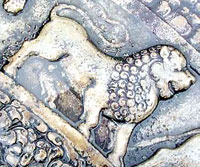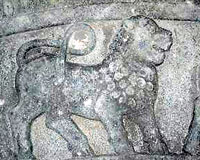Moonstone saga unearths uncovered ground
View(s):As a “study report” reveals that the recent moonstone discovered in London may not belong to the Anuradhapura Period, the need for recording and protecting artefacts comes to light. Kumudini Hettiarachchi and Shaveen Jeewandara report
A tentative verdict is in. The sandakada pahana (moonstone) that is to go under the gavel at the Bonhams auction next month is not from the Anuradhapura Period.
It is a replica of the original moonstones of that period, said the Director-General of Archaeology, Dr. Senarath Dissanayake, adding that as such Sri Lanka will not ask for its return.
 One in London |
 One in Anuradhapura. Pictures courtesy the study |
“As it is not entirely clear in which timeframe the replica itself was made, we have taken rock samples to be sent to the University of Peradeniya for analysis,” he said.
This follows a “study report” entrusted by the Department of Archaeology to Sri Lankan doctoral student, Wijerathne Bohingamuwa, of the School of Archaeology, University of Oxford to verify the authenticity and if possible to establish the provenance of the artefact by physical examination and research.
According to the report the Bonhams’ moonstone measures 146cm (along the straight edge of the half lotus side) X 123cm (at the longest point from the half lotus end to the semi-circular edge). Its thickness varies from 14cm at the semi-circular end to 18cm in the centre of the half lotus end.
The artefact is perfectly preserved, states Mr. Bohingamuwa, except for the slight damage to the tusk of the last elephant in the southern most end of the animal procession panel. Effects of fungi growth, however, is clearly visible on the carved surface whereas the opposite side is rather fresh.
Pointing out that establishing the provenance and authenticity of artefacts detached from their contexts without any record is a “challenging task”, he explains that this is particularly true for artefacts in the antiquity market as auctioneers purposely mask the provenance and true history. With regard to the Bonhams’ moonstone, he says its history cannot be traced beyond 1950, although artistically and thematically it resembles the Late Anuradhapura Period moonstones, specifically moonstone Number 10 (in Anuradhapura) of C.E. Godakumbure’s publication “Sandakadapahana, Moonstones, Sri Lanka’ in 1967 under the auspices of the Archaelogical Department.
Comparing and contrasting the Bonhams’ moonstone and the one in Godakumbure’s publication, Mr. Bohingamuwa says that the latter moonstone and other known moonstones in Anuradhapura are of very fine quality and the details of the carvings are superior. Craftsmen have given more consideration to finer details of carvings since they had a message to convey and less attention to getting fine edges. The thickness of the stone slabs of the Anuradhapura genuine moonstones seems much thinner than the Bonhams’ moonstone which also shows some evidence of weathering.
“However considering the antiquity assigned to the artefact and the distance it is claimed to have travelled it may be expected to have more evidence of wear and tear…….when an artefact weighing three quarters of a ton travels over thousands of miles and moves over six times from place to place, it would be expected to witness the evidence of such a journey. Such evidence is meagre. Under these circumstances the antiquity and the authenticity assigned to the artefact, naturally, comes under the radar of suspicion,” he says.
With regard to efforts to determine the material/rock type used for the Bonhams’ moonstone, he says two views emerged: Local experts concluding it to be granitic gneiss and an Oxford expert that it is granite or micro granite. This issue may be resolved by petrological studies of the rock sample or examination of the moonstone by geologists/geo-archaeologists.
While lamenting the lack of data on moonstones and calling for the collection of information including scientific evidence on the material used to craft them, Mr. Bohingamuwa urges that his study should be considered “a preliminary investigation” but further research is called for, with a national committee of experts reaching a final decision.
He suggests that when dealing with the antiquity market not only the national and international laws and conventions prohibiting and preventing the illicit import, export and transfer of ownership of cultural property to which both Sri Lanka and the United Kingdom are signatories should be considered, but also professional ethics largely agreed on by professional and academic bodies of archaeology and museums be given due consideration. Not only the relevant officials but also the Sri Lankan missions overseas should be aware and kept updated on this information.
Going “beyond the issue of the moonstone in London”, Mr. Bohingamuwa underscores the need for a satisfactory inventory of archaeological sites, monuments and artefacts in Sri Lanka, particularly for the areas recently liberated. The Sunday Times on January 27, highlighted a strong plea by experts that the intricately-carved Bonhams’ moonstone which is to be auctioned on April 23 be returned to Sri Lanka
This was after the privately-owned British auction house issued a press release titled ‘Rare Buddhist Anuradhapura period (377 BC-1017 AD) Indian carved stone temple step discovered by Bonhams in a Devon garden will be sold in London’.
“This magnificent work of art featuring a cow and other animals has come to light in the garden of a Devon bungalow. It is estimated to attract bids in excess of
£ 30,000,” the press release said, adding that the beautiful 1,000-year-old pre-Hindu stone step is one of only six examples known to date from this period.
Differences in the moonstones
 The Anuradhapura Period lion |
 The Bonhams’ lion |
The report points out that moonstone No.10 shows finer details of animals and other decorations when compared to the Bonhams’ piece. The examples cited are:
n The tail of the left most/last elephant in No. 10 is coiled and looks very natural compared to that of the elephant in the Bonhams’ moonstone which is straight and far from being natural.
n The lion and the bull in the No. 10 moonstone (and most of the other Anuradhapura moonstones) are majestic and realistic than those in the Bonhams’ moonstone. The details of the mane/hair on the neck and the head of the lion and the neck muscle of the bull in No. 10 are extremely artistic and natural, as opposed to those in the other. It is the same with the representation of the horse as well.
Follow @timesonlinelk
comments powered by Disqus



















